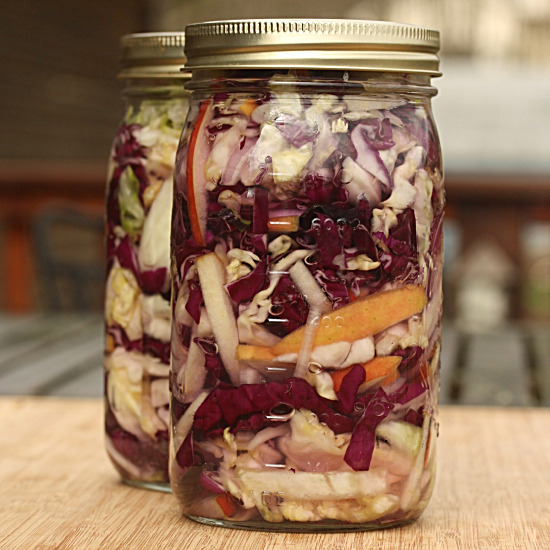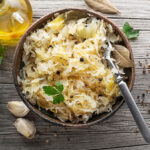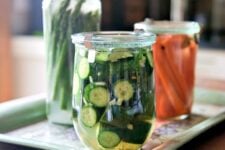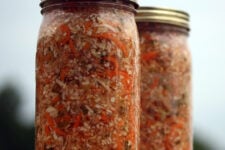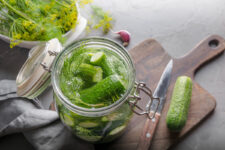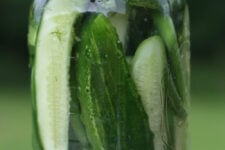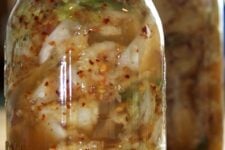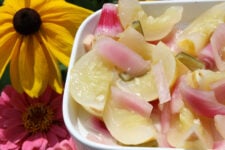Make your own Lacto-Fermented Sauerkraut at home with this simple recipe. All you need is cabbage, salt, and optional additions like caraway seeds, shallot, and apple. Enjoy this probiotic-rich, vitamin C-packed superfood with sandwiches, wraps, or as a healthy snack.
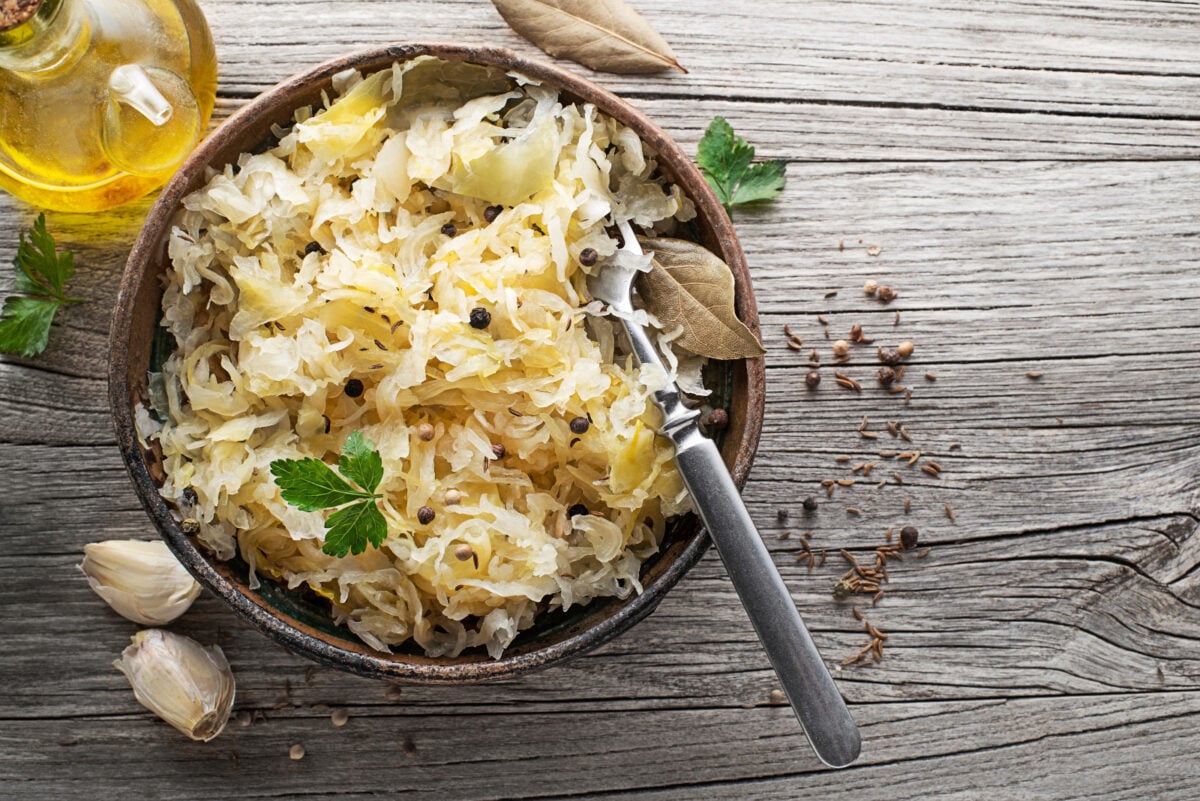
Lacto-fermented sauerkraut has so many things going for it: natural probiotics that aid the digestive and immune systems, tons of beneficial enzymes, lots of vitamin C…in my opinion, it’s truly a superfood.
If you’re unfamiliar with the concept of lacto-fermentation, don’t be intimidated by the word. It’s just the official term for the chemical process of “culturing” that takes place in the presence of lactic acid producing bacteria. This change increases the nutritional profile of the food being cultured, and makes it less prone to spoilage.
Beer, wine, cheese, olives and yogurt are foods you are familiar with that have been made using the lacto-fermentation method throughout history. Kimchi, tempeh, miso, kefir and kombucha are some more examples of lacto-fermented/cultured foods.
Nowadays, some of these foods (like commercial pickles, sauerkraut, and some yogurts) are mass-produced and are not actually lacto-fermented, though: they are preserved with sugar and vinegar or even cooked and pasteurized which kills the live enzymes and negates most of their health benefits.
So I think knowing how to make your own lacto-fermented foods is a valuable skill.
The cultural origins of sauerkraut are sort of murky. According to one of my favorite lacto-fermentation reference books, Wild Fermentation: The Flavor, Nutrition, and Craft of Live-Culture Foods by Sandor Katz , lacto-fermented cabbage was probably first made in China. It later became popular in Europe, particularly in Germany, where it is called sauerkraut (in France, it’s called choucroute). Katz says that adding apple to sauerkraut, something I like to do, is Russian in origin.
The way I make lacto-fermented sauerkraut, in small batches, is very simple. All you need is cabbage, salt, glass jars and some time. Other additions, such as caraway seeds, are optional…nature does the rest. While it’s helpful to have a food processor to do the shredding for you, it is absolutely not necessary. I shredded everything for this recipe by hand in a couple of minutes.

You can use all green cabbage or a combination of red and green like I have here. One small head of cabbage will yield about one quart of homemade sauerkraut, but I figure as long as you’re making one, you might as well make two. It keeps well and if you enjoy sauerkraut, I promise you’ll eat it up quickly. As is the case with all of my recipes, I recommend you use organic ingredients whenever possible.
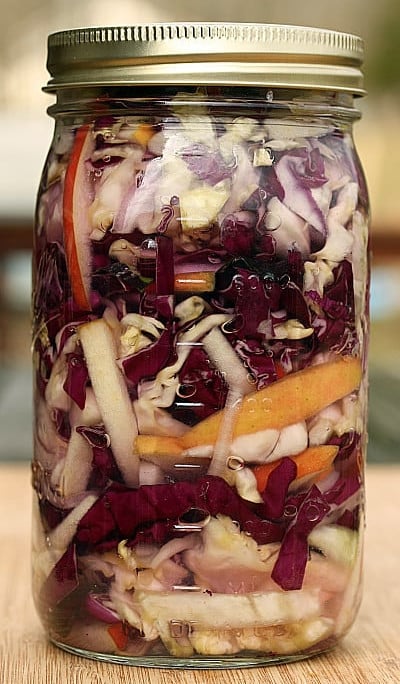
I eat sauerkraut on all sorts of sandwiches and in wraps (both veggie and those with meat), and I like it with scrambled eggs. It also makes a very healthy snack on its own. If you want to learn more about lacto-fermentation, Nourishing Traditions: The Cookbook that Challenges Politically Correct Nutrition and the Diet Dictocrats is a great book with lots of interesting recipes.
If you find that you really like making sauerkraut, you may want to invest in fermentation crock that uses ceramic weight stones to eliminate all chance of mold and allows fermentation gasses to escape without allowing air to enter.
A few more of my posts about lacto-fermenting:
Homemade Yogurt
Pickled Cukes and Garlic Scapes
Lemon Cucumber Pickles
Lacto-Fermented Sauerkraut
Ingredients
- 2 heads cabbage small heads, cored and shredded
- 1/2 tbsp caraway seed optional
- 3 tbsp sea salt
- 1 shallot optional; peeled and sliced thin
- 1 apple optional; shredded
Instructions
- In a large non-metal bowl, mix the cabbage with the optional caraway seeds and salt. Use your (clean!) hands to really work the salt into the cabbage, then allow to rest for 15-20 minutes. The cabbage will wilt and a salty brine will develop.
- Add the shallot and apple and mix well.
- Spoon the mixture into two quart-sized, wide-mouth mason jars, and as you do so, press down firmly with a pounder (the back of a wooden spoon will also do) until the juices come to the top of the cabbage. The top of the cabbage should be at least 1 inch below the top of the jar (this is because there will be some expansion while it is lacto-fermenting and you don't want it to overflow out of the jar). If there is not enough liquid, add enough filtered water so that the cabbage is just barely covered.
- Screw lids on to the jars (screw them tight) and keep at room temperature for about three days. Open the jars and see if the liquid is bubbly- if it is, you can transfer your jars to the refrigerator, where they will continue to lacto-ferment at a slower rate. You can eat your homemade sauerkraut right away, or wait a week or two for the flavors to develop further.
Notes
- a food processor makes quick work of shredding the cabbage, especially if you want a very fine texture, but it’s also fine to shred by hand
- I used one green and one red cabbage; you can do the same or use either color
- I like the bit of sweetness the apple provides, but it’s not necessary (make sure to peel if it is not organic)

